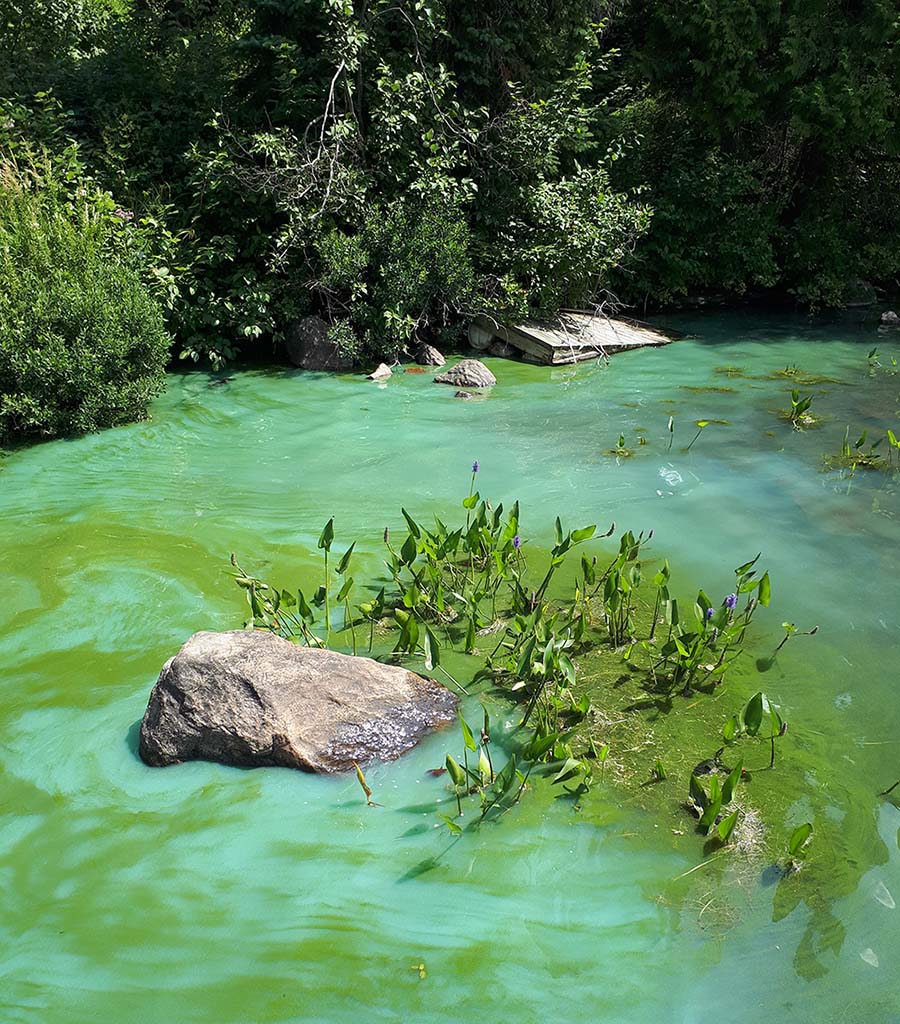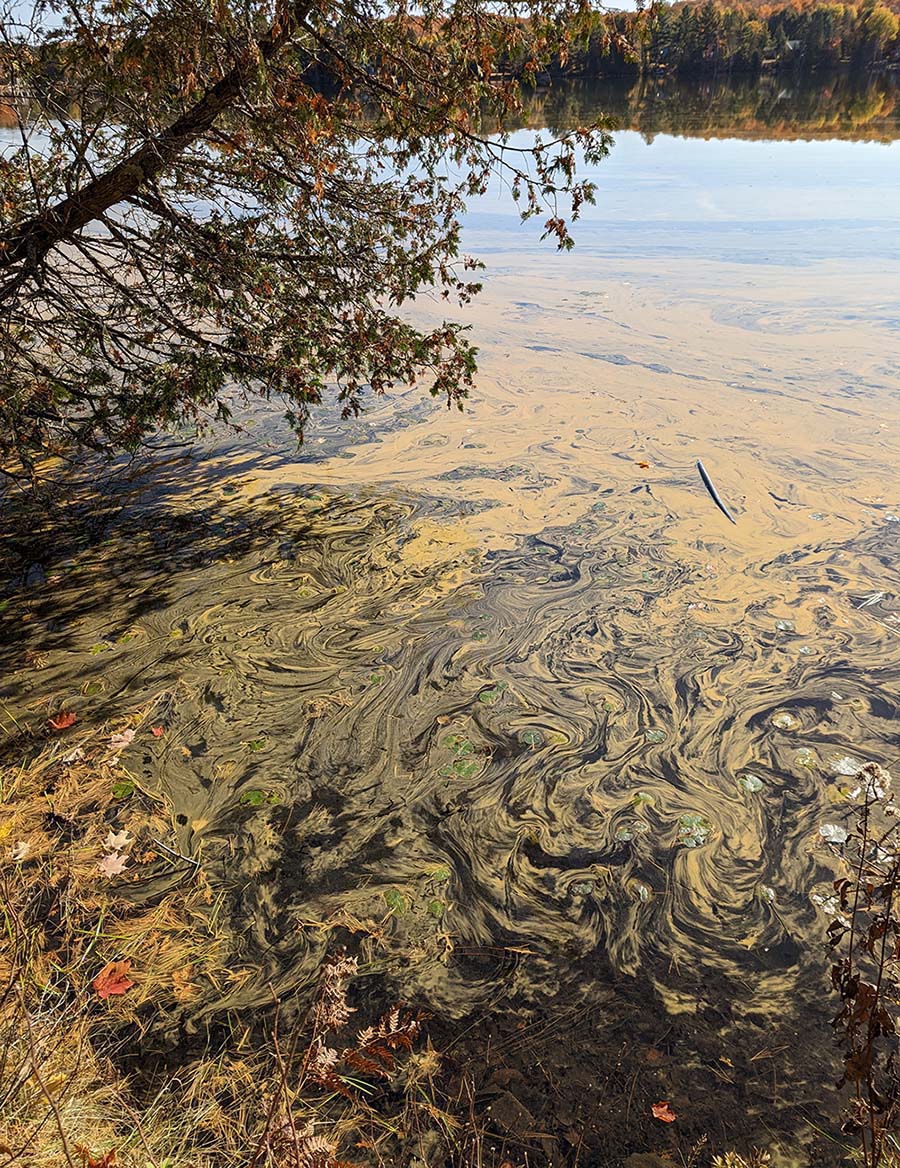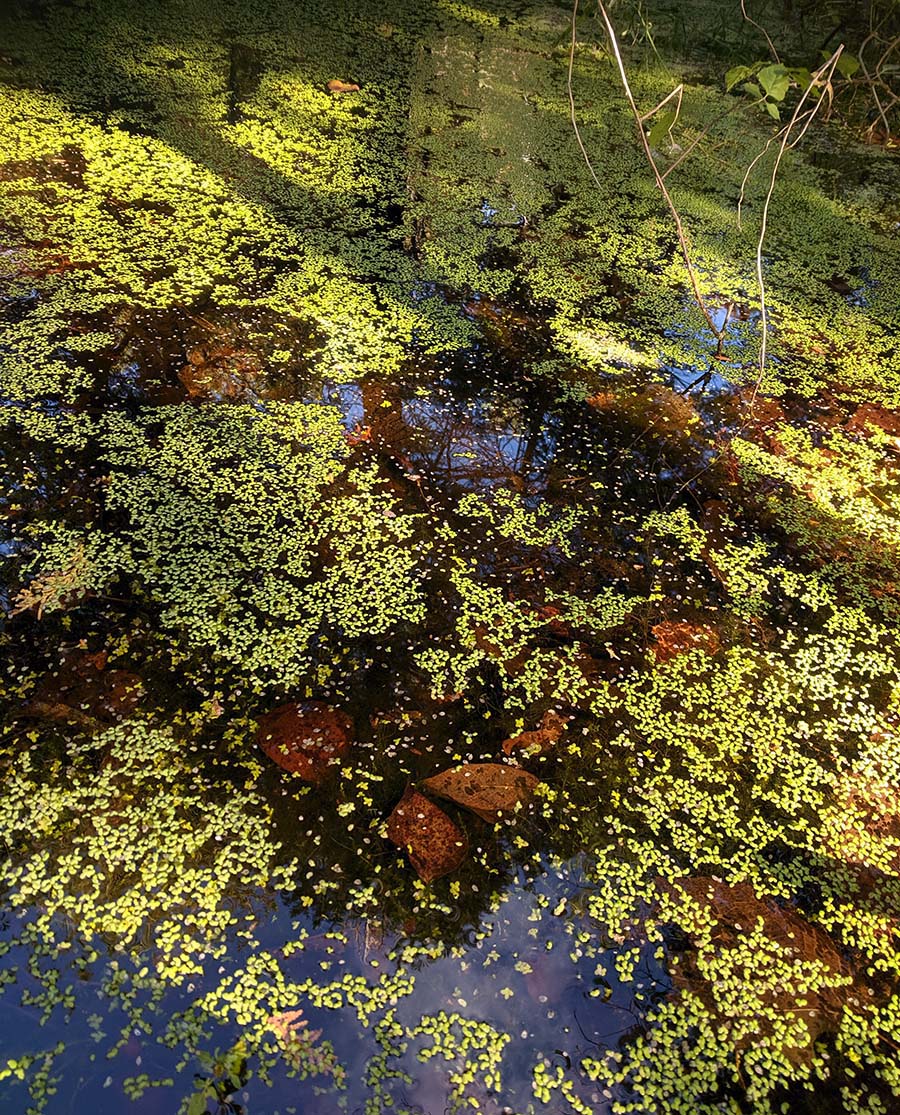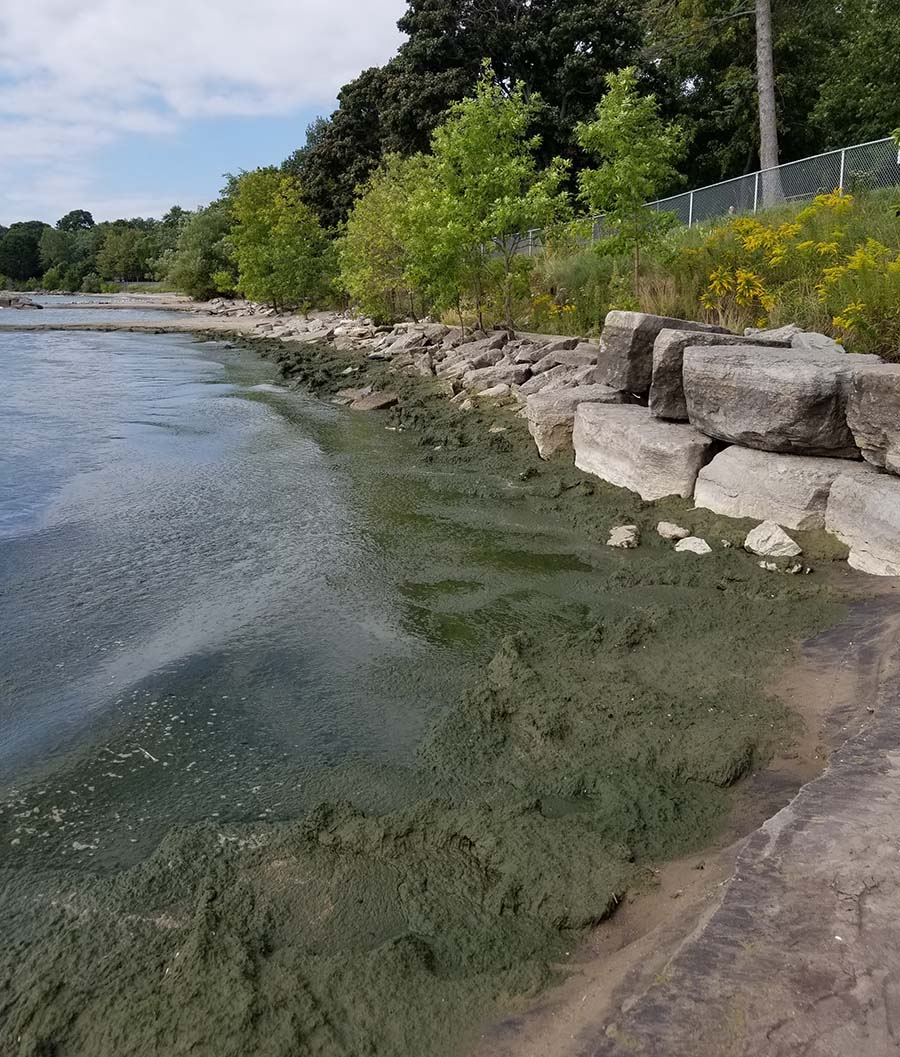Blue-green algae
Learn about blue-green algae and what Ontario is doing to help reduce blue-green algal blooms.
Avoid harmful blue-green algal blooms
If you think you see a blue-green algal bloom, avoid contact and do not drink the water.
You can’t tell if blooms contain harmful toxins just by looking at them. Keep people, pets and livestock away from all blooms.
Overview
Blue-green algae, also known as cyanobacteria, are microscopic, plant-like organisms that occur naturally in:
- lakes
- ponds
- rivers
- streams
Blue-green algae:
- thrive in areas where the water is shallow, slow-moving and warm
- may also be present in deeper, cooler water
- are not normally visible in water
Some varieties of blue-green algae can produce cyanotoxins, which are harmful to humans and animals.
Populations of blue-green algae can rapidly increase to form a large mass or scum, called a bloom. Blooms are most common in late summer or early fall but can also occur in other seasons. Bloom development can be promoted by conditions such as:
- calm water
- high temperatures
- increase in nutrients such as phosphorus
Blooms do not always reoccur in the same waterbodies.
How to recognize blue-green algal blooms
Dense blue-green algal blooms can look like green pea soup or turquoise paint. They can also be other colours such as yellow, purple, red or brown.
When the cells are very dense, they may form scums or solid-looking mats.


Plant matter and algae that can be mistaken for blue-green algal blooms
Aquatic plants
If mats have visible leaf-like structures and roots or stems, they are most likely aquatic plants, such as milfoil or duckweed, not blue-green algae.
Pollen
Heavy accumulations of pollen during spring may cause yellow scum in the water, which can be mistaken for blue-green algae.
Pollen is usually also visible on land, away from the waterbody.
Other types of algae
Other types of algae, such as green algae, also form blooms or mats that may look like blue-green algae.


Health effects of blue-green algal blooms
Some types of blue-green algae can produce cyanotoxins, including a group of toxins called microcystins.
Cyanotoxins are harmful to humans and animals. Human health effects from contact with cyanotoxins may include:
- itchy, irritated eyes and skin from direct contact through activities like swimming or water skiing
- flu-like symptoms, such as headache, fever, diarrhea, abdominal pain, nausea and vomiting, if large quantities of toxins are swallowed
Contact your local public health unit for information on the health risks of cyanotoxins.
What to do if you see a blue-green algal bloom
If you think you see a blue-green algal bloom:
- assume that toxins are present, because you can’t tell if toxins are present just by looking at a bloom
- avoid contact with the water, do not bathe or swim in it
- do not drink the water
- restrict pet and livestock access to the water
- report it
Report a suspected blue-green algal bloom
Submit a report online, or call the Spills Action Centre 24 hours a day, 7 days a week:
What happens when an algal bloom is reported
We have a protocol in place for responding to suspected harmful algal blooms.
We collaborate with local public health units and Medical Officers of Health to:
- manage incidents of blue-green algal blooms
- quickly screen samples to identify possible cyanotoxin risks
Public health units
- make decisions on public beach postings
- provide notices to local residents on drinking water concerns for non-regulated drinking water systems
- issue health advisories for blue-green algal blooms
For more information, including current health advisories for blue-green algal blooms, contact your local public health unit.
Eating fish caught during a blue-green algal bloom
There is low risk to human health if you eat fish caught during blue-green algal bloom conditions. Recent studies show that the cyanotoxin microcystin does not accumulate at high levels in fish fillets.
One exception is that higher levels of microcystins have been found in the livers of fish from waterbodies that regularly have blue-green algal blooms, even when a bloom is not present. Avoid eating any fish organs to eliminate this risk.
The Guide to Eating Ontario Fish has more information about safely eating fish.
Blue-green algae and drinking water
Municipal residential drinking water systems
Municipal residential drinking water systems that use surface water are required to:
- proactively monitor surface water sources for harmful algal blooms
- develop a harmful algal bloom sampling, monitoring and reporting plan as a condition of their municipal drinking water licence
- consider the impacts of harmful algal blooms when conducting required risk assessments
If a blue-green algal bloom impacts a municipal drinking water system, a system operator or the local public health unit will notify you to not drink or use the water.
Non-municipal drinking water systems
Non-municipal drinking water systems include privately-owned systems that serve:
- apartment buildings
- private subdivisions
- mobile home parks
Non-municipal systems are less likely to have the specialized equipment needed to effectively filter and treat water during harmful algal blooms.
If a blue-green algal bloom is suspected near an intake for these types of systems, owners and operators should contact their local public health unit or their local ministry office for direction.
Private water systems
If you have your own well supply with a groundwater source (not including shore wells or infiltration galleries), or you receive trucked water in cisterns, you can continue to use the water normally during a blue-green algal bloom.
If you get your water supply from your own surface water intake in the area of a blue-green algal bloom, you should consider an alternate source of drinking water and follow the direction provided by your local public health unit.
Home treatment systems may not remove cyanotoxins. These systems can easily get overwhelmed or clogged, so you should not rely on them to remove toxins.
Do not boil or manually treat the water with chlorine or other disinfectants—this does not remove the toxins.
What causes blue-green algal blooms
In Ontario waterbodies, phosphorus is a key nutrient that promotes algal growth.
Although some waterbodies are naturally enriched with phosphorus, human activities can elevate the level of nutrients, promoting the growth of blue-green algae when climatic conditions are favourable, such as calm water and high temperatures.
Nutrient sources can include:
- land or shoreline erosion
- agricultural activities
- urban runoff
- effluent from sewage treatment plants
- leaching from incorrectly functioning septic systems
Invasive species and climate change can also promote conditions that support blooms by causing increased nutrient levels.
How to reduce blue-green algal blooms
Take these simple steps to reduce blue-green algal blooms:
- maintain a natural shoreline on lake and riverfront properties
- use phosphate-free detergents, personal care and household cleaning products
- avoid using fertilizers on lawns, especially fertilizers containing phosphorus
- maintain your septic system to make sure it works correctly
- follow agricultural best management practices, such as:
- nutrient management planning
- maintaining vegetative buffers
- using cover crops
- having proper manure storage and application to prevent nutrient losses
- keeping livestock out of natural waterbodies
How to treat blue-green algal blooms
You should not treat blue-green algal blooms. Reducing nutrient loads from human activities is the best way to reduce blooms.
Herbicides, copper sulphate or other algaecides may cause the algae cells to release toxins into the water. This makes treating blue-green algal blooms difficult.
How we are addressing blue-green algal blooms
Ontario is concerned about the effects of blue-green algal blooms in our lakes and rivers. We are taking action to address the impact to the Great Lakes and other waterbodies.
Working with partners
We are working with municipalities, local medical officers of health and other partners to:
- raise public awareness
- protect drinking water sources
- reduce nutrients that promote the growth of algae
- support science and innovation to better understand algal blooms
- administer legislation, regulations, policies and programs to protect water quality
Initiatives and partnerships
We are reducing nutrient pollution and protecting Ontario waterbodies through initiatives and partnerships, including:
- Source Protection Plans under the Clean Water Act
- Lake Simcoe Protection Plan
- Excess Soil Management Regulation
- Ontario’s Great Lakes Strategy
- Canada-Ontario Agreement on Great Lakes Water Quality and Ecosystem Health
- Canada-U.S. Great Lakes Water Quality Agreement
- Canada-Ontario Lake Erie Action Plan
- Western Basin of Lake Erie Collaborative Agreement
- Lake Friendly Accord
Our agreements with other Great Lakes jurisdictions will:
- help reduce the amount of nutrients in Ontario’s waterways
- develop action plans and strategies
- establish nutrient targets, such as the Lake Erie target to reduce phosphorus loadings
Find more information on our source and lake protection programs.
Examples of projects to reduce algal blooms
Ontario continues to work to better understand and reduce harmful and nuisance algal blooms. Some examples of projects the Ministry of the Environment, Conservation and Parks is leading or supporting include:
- Working with landowners to implement improved stewardship practices in rural and agricultural watersheds to help manage nutrient loads to local watercourses.
- Providing draft guidance and investments on innovative stormwater management approaches, such as green infrastructure and low impact development, which can improve stormwater quality and help prevent contaminants from flowing to local waterways and the Great Lakes.
- Naturalizing shorelines to reduce erosion and improving the ability of coastal and inland wetlands to control water flow and reduce phosphorus loadings.
- Continued monitoring and assessment of phosphorus loadings in key areas to support nutrient reduction efforts.
Protecting our drinking water sources
Across Ontario, local source protection plans use different strategies depending on the risk of blue-green algal blooms near drinking water intakes.
Plans may include:
- managing activities like storage and handling of manure and maintenance of sewage and septic systems, which can contribute nutrients and encourage blooms
- encouraging research to identify the causes of blooms
- increased monitoring
- providing information to watershed residents about reducing nutrient run-off
Improving nutrient management
We have invested funding to improve the health and water quality of our lakes and rivers. This includes:
- Investing more than $24 million and implementing 190 projects since 2018 through the Canada-Ontario Agreement and Great Lakes Strategy to reduce nutrients in the Great Lakes Basin.
- Investing in the Great Lakes Local Action Fund which has awarded nearly $880,000 to 18 local projects to protect water quality and shorelines along Lake Erie.
- Investing $30 million through the Wetlands Conservation Partner Program to support conservation organizations to enhance and restore wetlands in priority areas across Ontario. Funding may support projects to restore wetlands on marginal agricultural lands which may help:
- reduce nutrient run off
- improve water quality
- improve and increase habitats
- increase biodiversity
- Investing approximately $29.8 million to complete more than 1,160 projects through the Lake Erie Agriculture Demonstrating Sustainability Program (LEADS) under the Canadian Agricultural Partnership (2018-2023) to help keep our soil healthy and protect our waterways. As a result of the completed LEADS projects:
- more than 363,363 acres of farmland are now at reduced risk of soil loss
- more than 38,574 acres at-risk from soil health challenges benefitted from cover crops
- in the Lake Erie/Lake St. Clair watersheds, over 53,100 kilograms of phosphorus were effectively retained on agricultural fields, reducing edge-of-field phosphorus losses and protecting water resources, supporting the long-term sustainability of both agriculture and the environment
- Funding of 3 programs designed to support farmers in making their agricultural lands more productive and resilient as part of the Sustainable Canadian Agricultural Partnership. The Government of Canada and Ontario are committing more than $68 million to these programs through the Ontario Agricultural Sustainability Initiative (OASI). Together, the Resilient Agricultural Landscape Program (RALP), Agricultural Stewardship Initiative (ASI), and On-Farm Applied Research and Monitoring (ONFARM) program will:
- help reduce greenhouse gas emissions and sequester carbon
- adapt equipment and operating practices in support of soil health and water quality
- help farmers better understand and communicate best on-farm management practices
- Investing almost $10 million to increase transparency around monitoring and public reporting of bypasses and overflows from municipal sewage systems and $15 million to improve wastewater and stormwater discharges into Lake Ontario.
- Investing in the Ontario Community Infrastructure Fund (OCIF), which provides formula-based funding to help small, rural and northern municipalities and local services boards repair and rehabilitate critical infrastructure, including water and wastewater projects. Ontario is investing an additional $1 billion in this program over 5 years, which started in 2022.
Contact us
If you have questions about blue-green algae, contact your local ministry office.
To report a suspected blue-green algal bloom, submit a report online or contact the Spills Action Centre 24 hours a day, 7 days a week:
For water use advisories and information on health risks associated with cyanotoxins, contact your local public health unit.